Analyzing Cultural Miscommunication: India-Australia Business Context
VerifiedAdded on 2023/06/08
|9
|2193
|275
Essay
AI Summary
This essay explores the cultural differences in business communication between India and Australia, focusing on potential areas of miscommunication. It begins by outlining essential business etiquettes for Mary to follow when interacting with Mr. Sharma in an Indian business context, emphasizing the importance of greetings, family inquiries, appropriate attire, and indirect communication. The essay then employs Hofstede's cultural dimensions to pinpoint specific areas where cultural differences may lead to miscommunication, such as power distance, individualism, masculinity, uncertainty avoidance, and long-term orientation. For each dimension, the essay contrasts the values and preferences of India and Australia, highlighting potential challenges. Finally, the essay recommends that Mary adopt a geocentric approach, prioritize relationship-building, and avoid expecting immediate results, to foster a successful and long-term business relationship with Mr. Sharma. The overall conclusion stresses the need for cultural adaptability to enhance the success of business interactions between individuals from different cultural backgrounds.
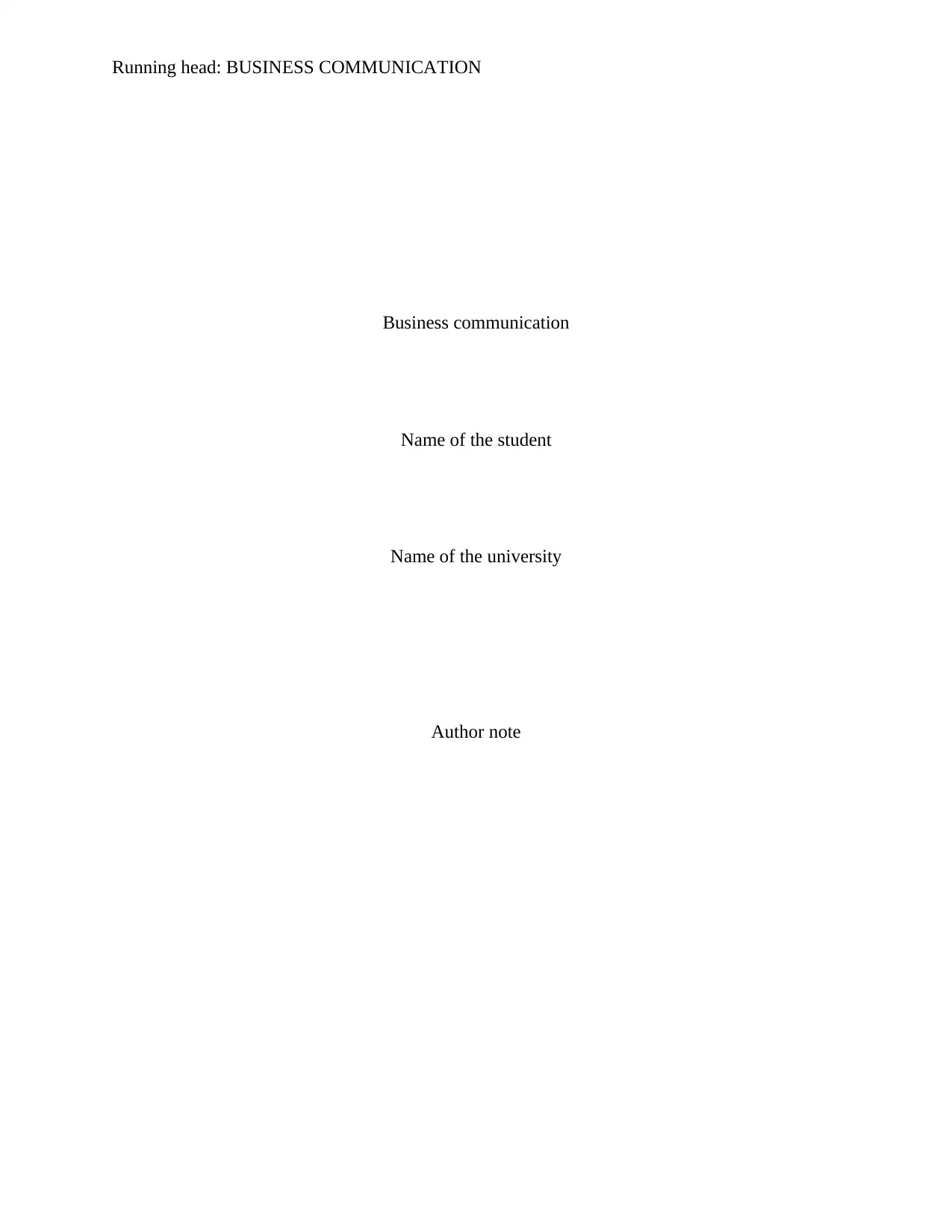
Running head: BUSINESS COMMUNICATION
Business communication
Name of the student
Name of the university
Author note
Business communication
Name of the student
Name of the university
Author note
Paraphrase This Document
Need a fresh take? Get an instant paraphrase of this document with our AI Paraphraser
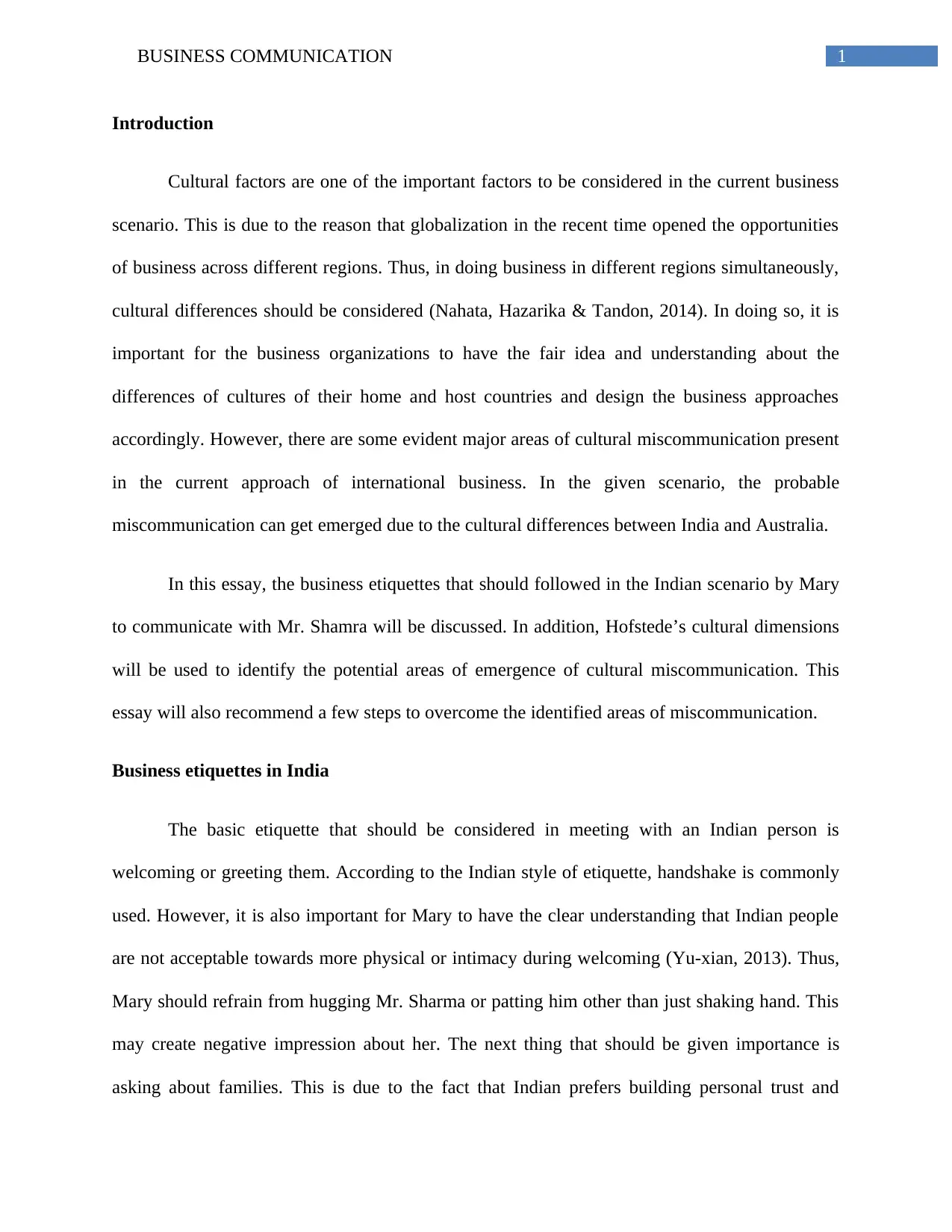
1BUSINESS COMMUNICATION
Introduction
Cultural factors are one of the important factors to be considered in the current business
scenario. This is due to the reason that globalization in the recent time opened the opportunities
of business across different regions. Thus, in doing business in different regions simultaneously,
cultural differences should be considered (Nahata, Hazarika & Tandon, 2014). In doing so, it is
important for the business organizations to have the fair idea and understanding about the
differences of cultures of their home and host countries and design the business approaches
accordingly. However, there are some evident major areas of cultural miscommunication present
in the current approach of international business. In the given scenario, the probable
miscommunication can get emerged due to the cultural differences between India and Australia.
In this essay, the business etiquettes that should followed in the Indian scenario by Mary
to communicate with Mr. Shamra will be discussed. In addition, Hofstede’s cultural dimensions
will be used to identify the potential areas of emergence of cultural miscommunication. This
essay will also recommend a few steps to overcome the identified areas of miscommunication.
Business etiquettes in India
The basic etiquette that should be considered in meeting with an Indian person is
welcoming or greeting them. According to the Indian style of etiquette, handshake is commonly
used. However, it is also important for Mary to have the clear understanding that Indian people
are not acceptable towards more physical or intimacy during welcoming (Yu-xian, 2013). Thus,
Mary should refrain from hugging Mr. Sharma or patting him other than just shaking hand. This
may create negative impression about her. The next thing that should be given importance is
asking about families. This is due to the fact that Indian prefers building personal trust and
Introduction
Cultural factors are one of the important factors to be considered in the current business
scenario. This is due to the reason that globalization in the recent time opened the opportunities
of business across different regions. Thus, in doing business in different regions simultaneously,
cultural differences should be considered (Nahata, Hazarika & Tandon, 2014). In doing so, it is
important for the business organizations to have the fair idea and understanding about the
differences of cultures of their home and host countries and design the business approaches
accordingly. However, there are some evident major areas of cultural miscommunication present
in the current approach of international business. In the given scenario, the probable
miscommunication can get emerged due to the cultural differences between India and Australia.
In this essay, the business etiquettes that should followed in the Indian scenario by Mary
to communicate with Mr. Shamra will be discussed. In addition, Hofstede’s cultural dimensions
will be used to identify the potential areas of emergence of cultural miscommunication. This
essay will also recommend a few steps to overcome the identified areas of miscommunication.
Business etiquettes in India
The basic etiquette that should be considered in meeting with an Indian person is
welcoming or greeting them. According to the Indian style of etiquette, handshake is commonly
used. However, it is also important for Mary to have the clear understanding that Indian people
are not acceptable towards more physical or intimacy during welcoming (Yu-xian, 2013). Thus,
Mary should refrain from hugging Mr. Sharma or patting him other than just shaking hand. This
may create negative impression about her. The next thing that should be given importance is
asking about families. This is due to the fact that Indian prefers building personal trust and
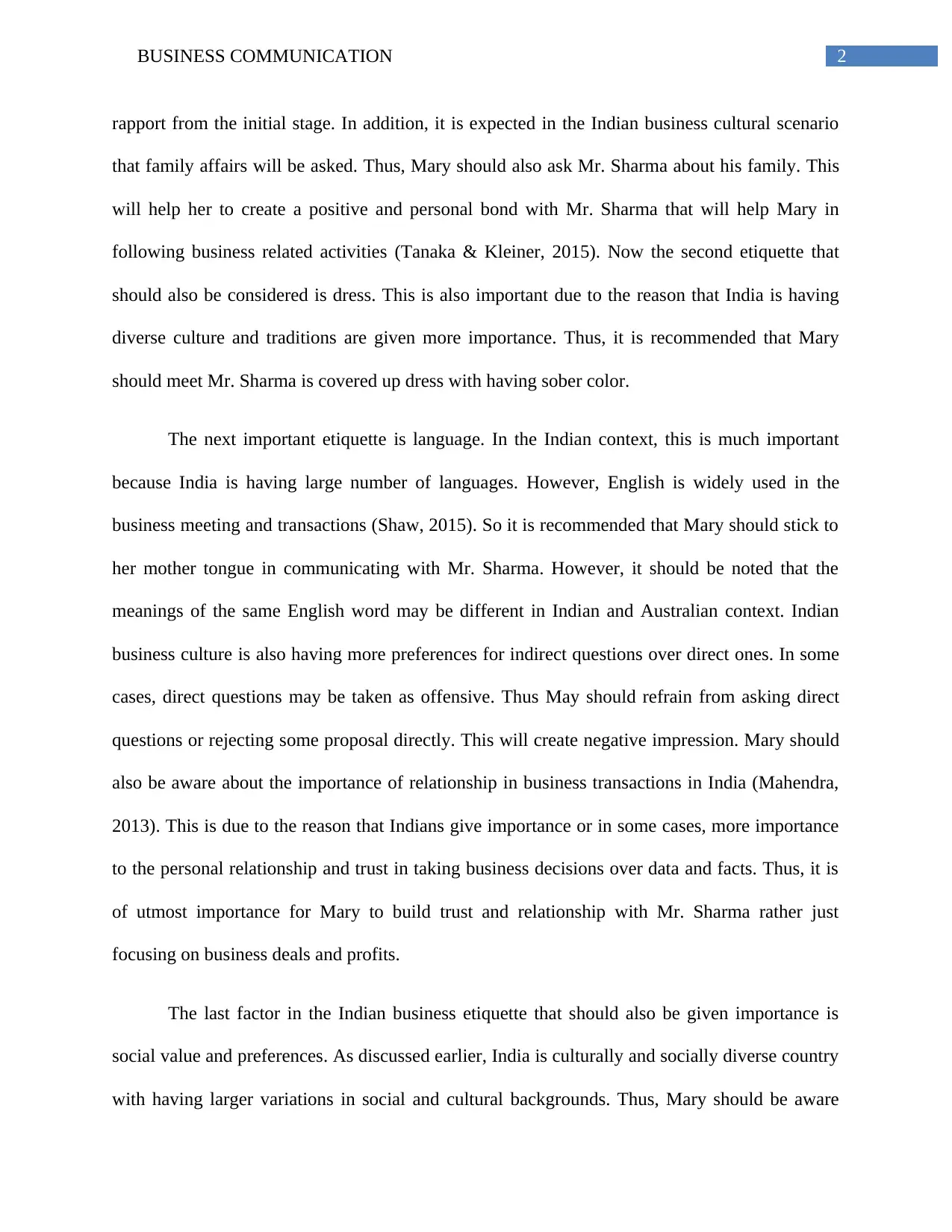
2BUSINESS COMMUNICATION
rapport from the initial stage. In addition, it is expected in the Indian business cultural scenario
that family affairs will be asked. Thus, Mary should also ask Mr. Sharma about his family. This
will help her to create a positive and personal bond with Mr. Sharma that will help Mary in
following business related activities (Tanaka & Kleiner, 2015). Now the second etiquette that
should also be considered is dress. This is also important due to the reason that India is having
diverse culture and traditions are given more importance. Thus, it is recommended that Mary
should meet Mr. Sharma is covered up dress with having sober color.
The next important etiquette is language. In the Indian context, this is much important
because India is having large number of languages. However, English is widely used in the
business meeting and transactions (Shaw, 2015). So it is recommended that Mary should stick to
her mother tongue in communicating with Mr. Sharma. However, it should be noted that the
meanings of the same English word may be different in Indian and Australian context. Indian
business culture is also having more preferences for indirect questions over direct ones. In some
cases, direct questions may be taken as offensive. Thus May should refrain from asking direct
questions or rejecting some proposal directly. This will create negative impression. Mary should
also be aware about the importance of relationship in business transactions in India (Mahendra,
2013). This is due to the reason that Indians give importance or in some cases, more importance
to the personal relationship and trust in taking business decisions over data and facts. Thus, it is
of utmost importance for Mary to build trust and relationship with Mr. Sharma rather just
focusing on business deals and profits.
The last factor in the Indian business etiquette that should also be given importance is
social value and preferences. As discussed earlier, India is culturally and socially diverse country
with having larger variations in social and cultural backgrounds. Thus, Mary should be aware
rapport from the initial stage. In addition, it is expected in the Indian business cultural scenario
that family affairs will be asked. Thus, Mary should also ask Mr. Sharma about his family. This
will help her to create a positive and personal bond with Mr. Sharma that will help Mary in
following business related activities (Tanaka & Kleiner, 2015). Now the second etiquette that
should also be considered is dress. This is also important due to the reason that India is having
diverse culture and traditions are given more importance. Thus, it is recommended that Mary
should meet Mr. Sharma is covered up dress with having sober color.
The next important etiquette is language. In the Indian context, this is much important
because India is having large number of languages. However, English is widely used in the
business meeting and transactions (Shaw, 2015). So it is recommended that Mary should stick to
her mother tongue in communicating with Mr. Sharma. However, it should be noted that the
meanings of the same English word may be different in Indian and Australian context. Indian
business culture is also having more preferences for indirect questions over direct ones. In some
cases, direct questions may be taken as offensive. Thus May should refrain from asking direct
questions or rejecting some proposal directly. This will create negative impression. Mary should
also be aware about the importance of relationship in business transactions in India (Mahendra,
2013). This is due to the reason that Indians give importance or in some cases, more importance
to the personal relationship and trust in taking business decisions over data and facts. Thus, it is
of utmost importance for Mary to build trust and relationship with Mr. Sharma rather just
focusing on business deals and profits.
The last factor in the Indian business etiquette that should also be given importance is
social value and preferences. As discussed earlier, India is culturally and socially diverse country
with having larger variations in social and cultural backgrounds. Thus, Mary should be aware
⊘ This is a preview!⊘
Do you want full access?
Subscribe today to unlock all pages.

Trusted by 1+ million students worldwide
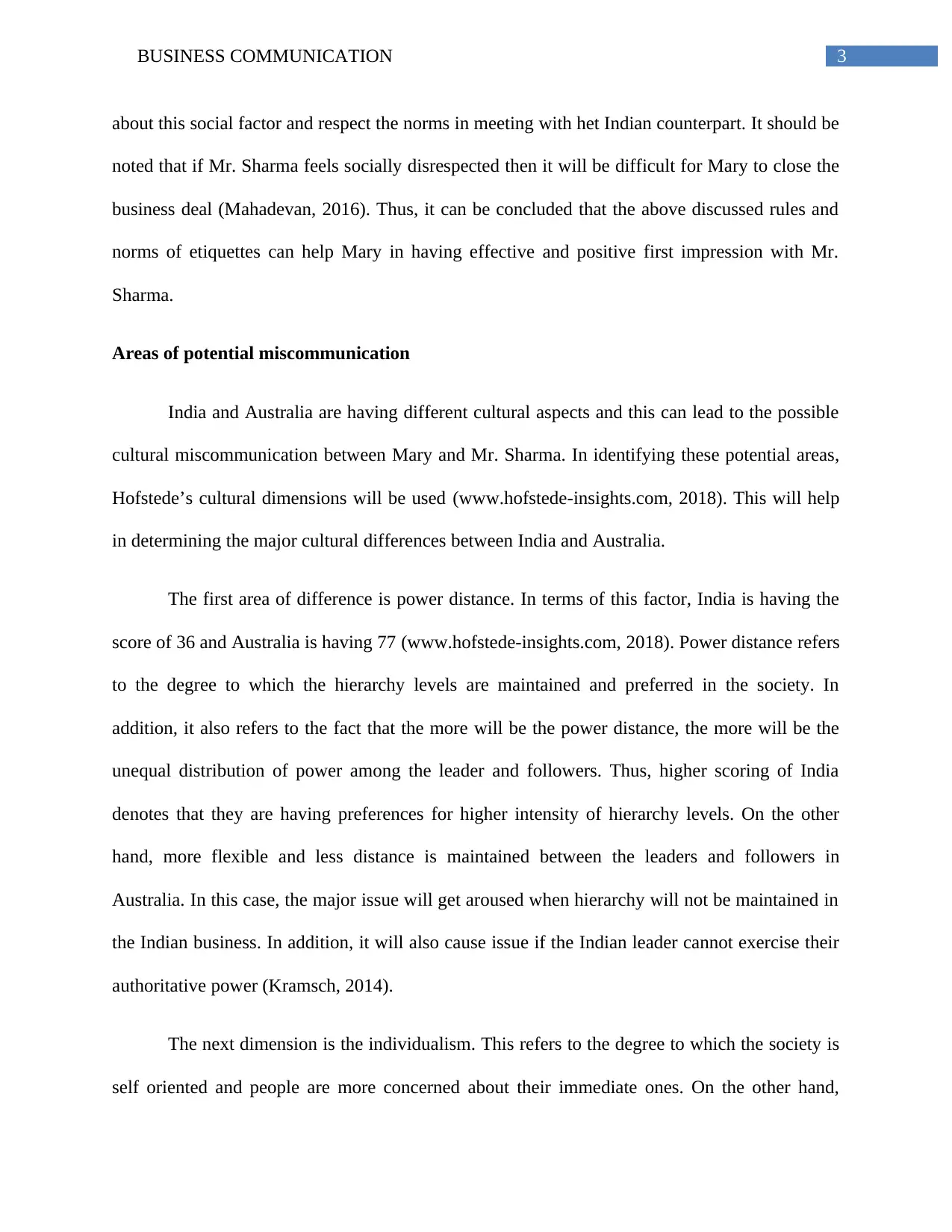
3BUSINESS COMMUNICATION
about this social factor and respect the norms in meeting with het Indian counterpart. It should be
noted that if Mr. Sharma feels socially disrespected then it will be difficult for Mary to close the
business deal (Mahadevan, 2016). Thus, it can be concluded that the above discussed rules and
norms of etiquettes can help Mary in having effective and positive first impression with Mr.
Sharma.
Areas of potential miscommunication
India and Australia are having different cultural aspects and this can lead to the possible
cultural miscommunication between Mary and Mr. Sharma. In identifying these potential areas,
Hofstede’s cultural dimensions will be used (www.hofstede-insights.com, 2018). This will help
in determining the major cultural differences between India and Australia.
The first area of difference is power distance. In terms of this factor, India is having the
score of 36 and Australia is having 77 (www.hofstede-insights.com, 2018). Power distance refers
to the degree to which the hierarchy levels are maintained and preferred in the society. In
addition, it also refers to the fact that the more will be the power distance, the more will be the
unequal distribution of power among the leader and followers. Thus, higher scoring of India
denotes that they are having preferences for higher intensity of hierarchy levels. On the other
hand, more flexible and less distance is maintained between the leaders and followers in
Australia. In this case, the major issue will get aroused when hierarchy will not be maintained in
the Indian business. In addition, it will also cause issue if the Indian leader cannot exercise their
authoritative power (Kramsch, 2014).
The next dimension is the individualism. This refers to the degree to which the society is
self oriented and people are more concerned about their immediate ones. On the other hand,
about this social factor and respect the norms in meeting with het Indian counterpart. It should be
noted that if Mr. Sharma feels socially disrespected then it will be difficult for Mary to close the
business deal (Mahadevan, 2016). Thus, it can be concluded that the above discussed rules and
norms of etiquettes can help Mary in having effective and positive first impression with Mr.
Sharma.
Areas of potential miscommunication
India and Australia are having different cultural aspects and this can lead to the possible
cultural miscommunication between Mary and Mr. Sharma. In identifying these potential areas,
Hofstede’s cultural dimensions will be used (www.hofstede-insights.com, 2018). This will help
in determining the major cultural differences between India and Australia.
The first area of difference is power distance. In terms of this factor, India is having the
score of 36 and Australia is having 77 (www.hofstede-insights.com, 2018). Power distance refers
to the degree to which the hierarchy levels are maintained and preferred in the society. In
addition, it also refers to the fact that the more will be the power distance, the more will be the
unequal distribution of power among the leader and followers. Thus, higher scoring of India
denotes that they are having preferences for higher intensity of hierarchy levels. On the other
hand, more flexible and less distance is maintained between the leaders and followers in
Australia. In this case, the major issue will get aroused when hierarchy will not be maintained in
the Indian business. In addition, it will also cause issue if the Indian leader cannot exercise their
authoritative power (Kramsch, 2014).
The next dimension is the individualism. This refers to the degree to which the society is
self oriented and people are more concerned about their immediate ones. On the other hand,
Paraphrase This Document
Need a fresh take? Get an instant paraphrase of this document with our AI Paraphraser
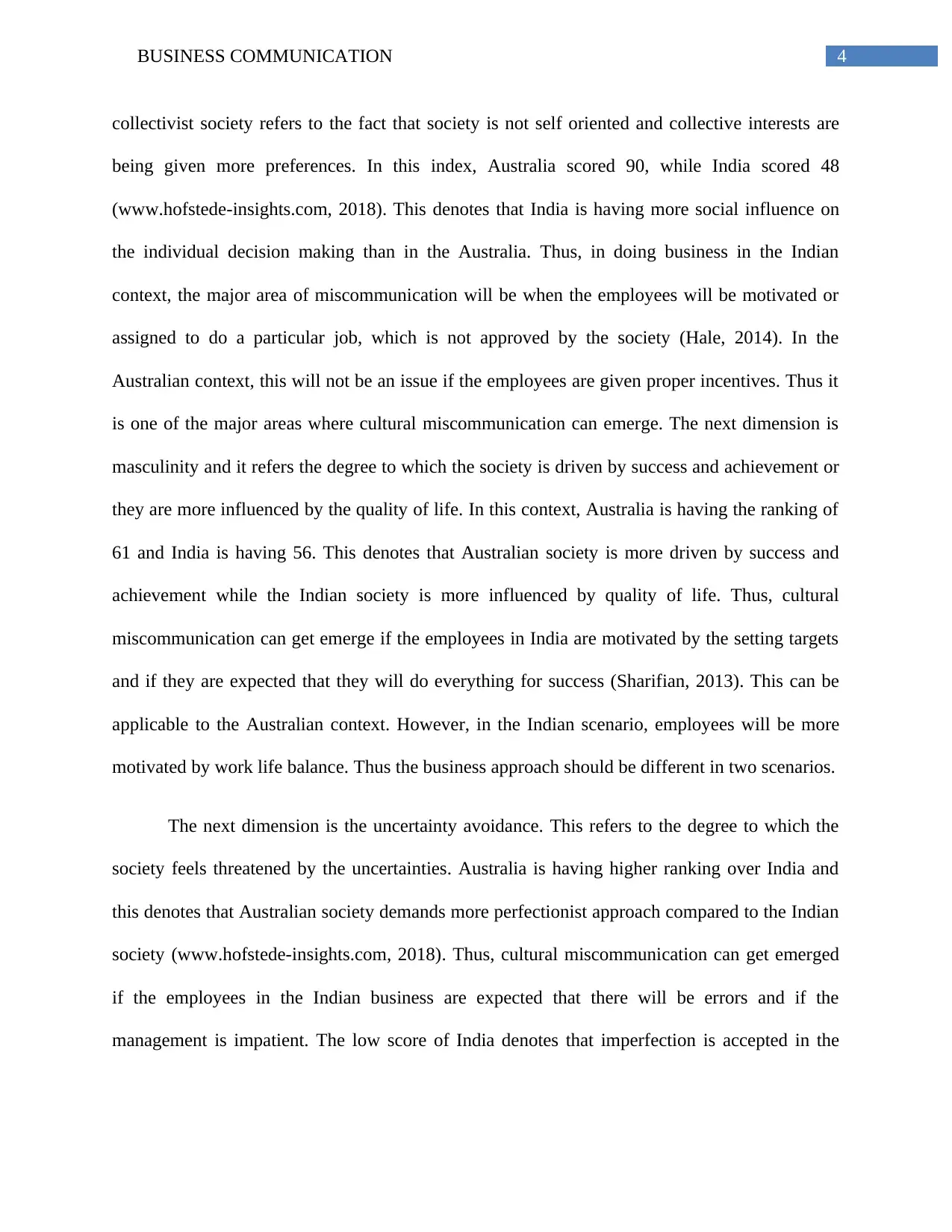
4BUSINESS COMMUNICATION
collectivist society refers to the fact that society is not self oriented and collective interests are
being given more preferences. In this index, Australia scored 90, while India scored 48
(www.hofstede-insights.com, 2018). This denotes that India is having more social influence on
the individual decision making than in the Australia. Thus, in doing business in the Indian
context, the major area of miscommunication will be when the employees will be motivated or
assigned to do a particular job, which is not approved by the society (Hale, 2014). In the
Australian context, this will not be an issue if the employees are given proper incentives. Thus it
is one of the major areas where cultural miscommunication can emerge. The next dimension is
masculinity and it refers the degree to which the society is driven by success and achievement or
they are more influenced by the quality of life. In this context, Australia is having the ranking of
61 and India is having 56. This denotes that Australian society is more driven by success and
achievement while the Indian society is more influenced by quality of life. Thus, cultural
miscommunication can get emerge if the employees in India are motivated by the setting targets
and if they are expected that they will do everything for success (Sharifian, 2013). This can be
applicable to the Australian context. However, in the Indian scenario, employees will be more
motivated by work life balance. Thus the business approach should be different in two scenarios.
The next dimension is the uncertainty avoidance. This refers to the degree to which the
society feels threatened by the uncertainties. Australia is having higher ranking over India and
this denotes that Australian society demands more perfectionist approach compared to the Indian
society (www.hofstede-insights.com, 2018). Thus, cultural miscommunication can get emerged
if the employees in the Indian business are expected that there will be errors and if the
management is impatient. The low score of India denotes that imperfection is accepted in the
collectivist society refers to the fact that society is not self oriented and collective interests are
being given more preferences. In this index, Australia scored 90, while India scored 48
(www.hofstede-insights.com, 2018). This denotes that India is having more social influence on
the individual decision making than in the Australia. Thus, in doing business in the Indian
context, the major area of miscommunication will be when the employees will be motivated or
assigned to do a particular job, which is not approved by the society (Hale, 2014). In the
Australian context, this will not be an issue if the employees are given proper incentives. Thus it
is one of the major areas where cultural miscommunication can emerge. The next dimension is
masculinity and it refers the degree to which the society is driven by success and achievement or
they are more influenced by the quality of life. In this context, Australia is having the ranking of
61 and India is having 56. This denotes that Australian society is more driven by success and
achievement while the Indian society is more influenced by quality of life. Thus, cultural
miscommunication can get emerge if the employees in India are motivated by the setting targets
and if they are expected that they will do everything for success (Sharifian, 2013). This can be
applicable to the Australian context. However, in the Indian scenario, employees will be more
motivated by work life balance. Thus the business approach should be different in two scenarios.
The next dimension is the uncertainty avoidance. This refers to the degree to which the
society feels threatened by the uncertainties. Australia is having higher ranking over India and
this denotes that Australian society demands more perfectionist approach compared to the Indian
society (www.hofstede-insights.com, 2018). Thus, cultural miscommunication can get emerged
if the employees in the Indian business are expected that there will be errors and if the
management is impatient. The low score of India denotes that imperfection is accepted in the
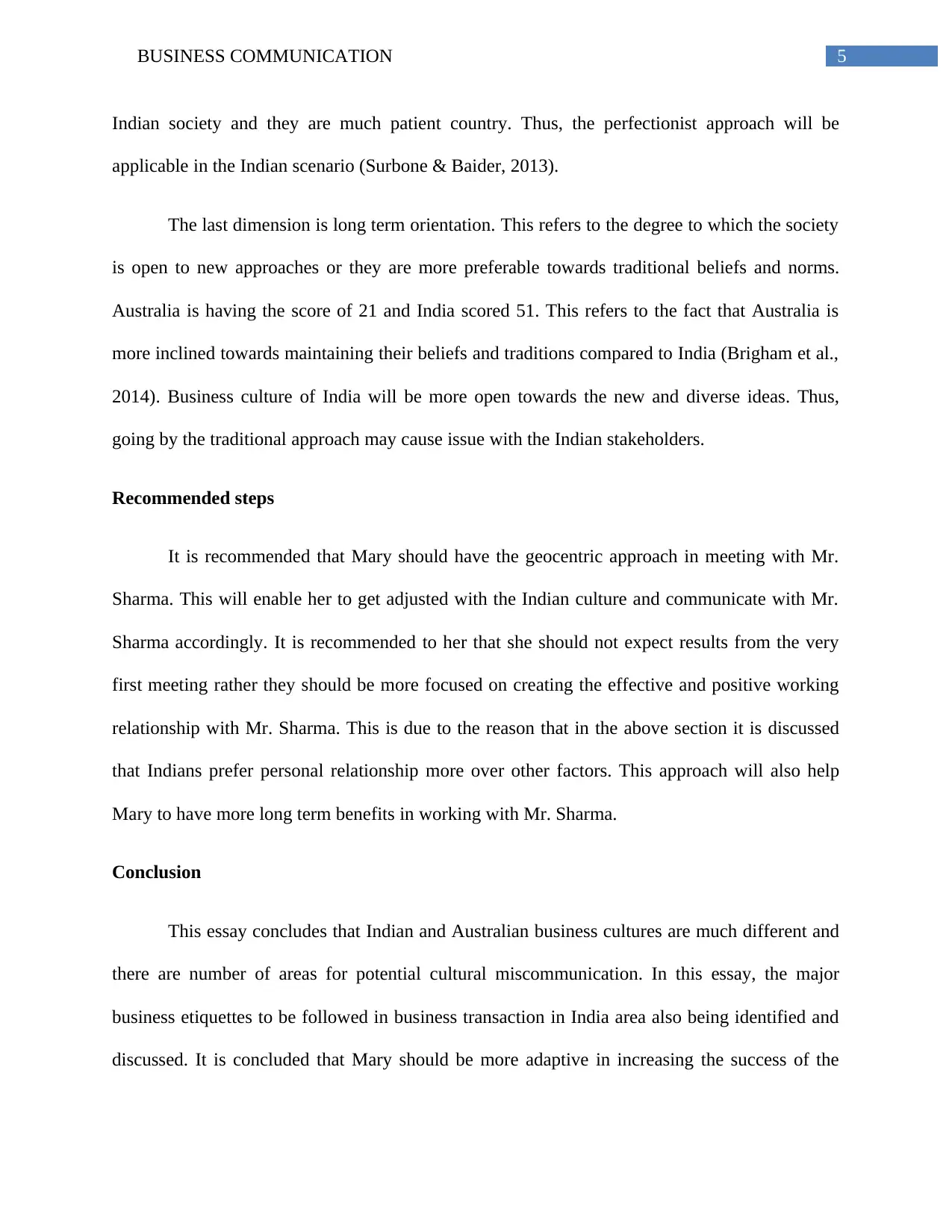
5BUSINESS COMMUNICATION
Indian society and they are much patient country. Thus, the perfectionist approach will be
applicable in the Indian scenario (Surbone & Baider, 2013).
The last dimension is long term orientation. This refers to the degree to which the society
is open to new approaches or they are more preferable towards traditional beliefs and norms.
Australia is having the score of 21 and India scored 51. This refers to the fact that Australia is
more inclined towards maintaining their beliefs and traditions compared to India (Brigham et al.,
2014). Business culture of India will be more open towards the new and diverse ideas. Thus,
going by the traditional approach may cause issue with the Indian stakeholders.
Recommended steps
It is recommended that Mary should have the geocentric approach in meeting with Mr.
Sharma. This will enable her to get adjusted with the Indian culture and communicate with Mr.
Sharma accordingly. It is recommended to her that she should not expect results from the very
first meeting rather they should be more focused on creating the effective and positive working
relationship with Mr. Sharma. This is due to the reason that in the above section it is discussed
that Indians prefer personal relationship more over other factors. This approach will also help
Mary to have more long term benefits in working with Mr. Sharma.
Conclusion
This essay concludes that Indian and Australian business cultures are much different and
there are number of areas for potential cultural miscommunication. In this essay, the major
business etiquettes to be followed in business transaction in India area also being identified and
discussed. It is concluded that Mary should be more adaptive in increasing the success of the
Indian society and they are much patient country. Thus, the perfectionist approach will be
applicable in the Indian scenario (Surbone & Baider, 2013).
The last dimension is long term orientation. This refers to the degree to which the society
is open to new approaches or they are more preferable towards traditional beliefs and norms.
Australia is having the score of 21 and India scored 51. This refers to the fact that Australia is
more inclined towards maintaining their beliefs and traditions compared to India (Brigham et al.,
2014). Business culture of India will be more open towards the new and diverse ideas. Thus,
going by the traditional approach may cause issue with the Indian stakeholders.
Recommended steps
It is recommended that Mary should have the geocentric approach in meeting with Mr.
Sharma. This will enable her to get adjusted with the Indian culture and communicate with Mr.
Sharma accordingly. It is recommended to her that she should not expect results from the very
first meeting rather they should be more focused on creating the effective and positive working
relationship with Mr. Sharma. This is due to the reason that in the above section it is discussed
that Indians prefer personal relationship more over other factors. This approach will also help
Mary to have more long term benefits in working with Mr. Sharma.
Conclusion
This essay concludes that Indian and Australian business cultures are much different and
there are number of areas for potential cultural miscommunication. In this essay, the major
business etiquettes to be followed in business transaction in India area also being identified and
discussed. It is concluded that Mary should be more adaptive in increasing the success of the
⊘ This is a preview!⊘
Do you want full access?
Subscribe today to unlock all pages.

Trusted by 1+ million students worldwide

6BUSINESS COMMUNICATION
meeting. It is expected that adaptive approach of Mary will not only help in increasing the
success of the meeting but also the enhancing the future potentiality of the business.
meeting. It is expected that adaptive approach of Mary will not only help in increasing the
success of the meeting but also the enhancing the future potentiality of the business.
Paraphrase This Document
Need a fresh take? Get an instant paraphrase of this document with our AI Paraphraser
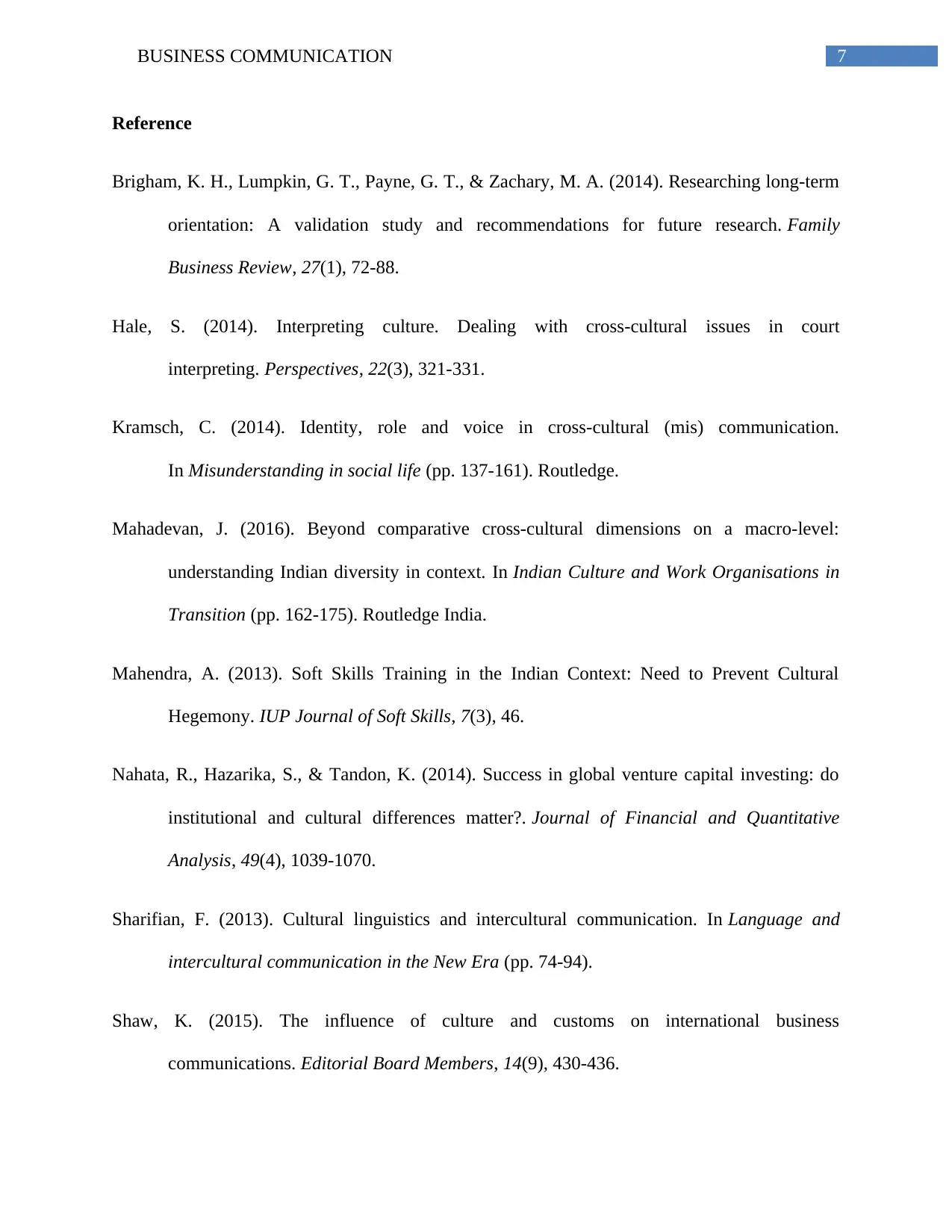
7BUSINESS COMMUNICATION
Reference
Brigham, K. H., Lumpkin, G. T., Payne, G. T., & Zachary, M. A. (2014). Researching long-term
orientation: A validation study and recommendations for future research. Family
Business Review, 27(1), 72-88.
Hale, S. (2014). Interpreting culture. Dealing with cross-cultural issues in court
interpreting. Perspectives, 22(3), 321-331.
Kramsch, C. (2014). Identity, role and voice in cross-cultural (mis) communication.
In Misunderstanding in social life (pp. 137-161). Routledge.
Mahadevan, J. (2016). Beyond comparative cross-cultural dimensions on a macro-level:
understanding Indian diversity in context. In Indian Culture and Work Organisations in
Transition (pp. 162-175). Routledge India.
Mahendra, A. (2013). Soft Skills Training in the Indian Context: Need to Prevent Cultural
Hegemony. IUP Journal of Soft Skills, 7(3), 46.
Nahata, R., Hazarika, S., & Tandon, K. (2014). Success in global venture capital investing: do
institutional and cultural differences matter?. Journal of Financial and Quantitative
Analysis, 49(4), 1039-1070.
Sharifian, F. (2013). Cultural linguistics and intercultural communication. In Language and
intercultural communication in the New Era (pp. 74-94).
Shaw, K. (2015). The influence of culture and customs on international business
communications. Editorial Board Members, 14(9), 430-436.
Reference
Brigham, K. H., Lumpkin, G. T., Payne, G. T., & Zachary, M. A. (2014). Researching long-term
orientation: A validation study and recommendations for future research. Family
Business Review, 27(1), 72-88.
Hale, S. (2014). Interpreting culture. Dealing with cross-cultural issues in court
interpreting. Perspectives, 22(3), 321-331.
Kramsch, C. (2014). Identity, role and voice in cross-cultural (mis) communication.
In Misunderstanding in social life (pp. 137-161). Routledge.
Mahadevan, J. (2016). Beyond comparative cross-cultural dimensions on a macro-level:
understanding Indian diversity in context. In Indian Culture and Work Organisations in
Transition (pp. 162-175). Routledge India.
Mahendra, A. (2013). Soft Skills Training in the Indian Context: Need to Prevent Cultural
Hegemony. IUP Journal of Soft Skills, 7(3), 46.
Nahata, R., Hazarika, S., & Tandon, K. (2014). Success in global venture capital investing: do
institutional and cultural differences matter?. Journal of Financial and Quantitative
Analysis, 49(4), 1039-1070.
Sharifian, F. (2013). Cultural linguistics and intercultural communication. In Language and
intercultural communication in the New Era (pp. 74-94).
Shaw, K. (2015). The influence of culture and customs on international business
communications. Editorial Board Members, 14(9), 430-436.
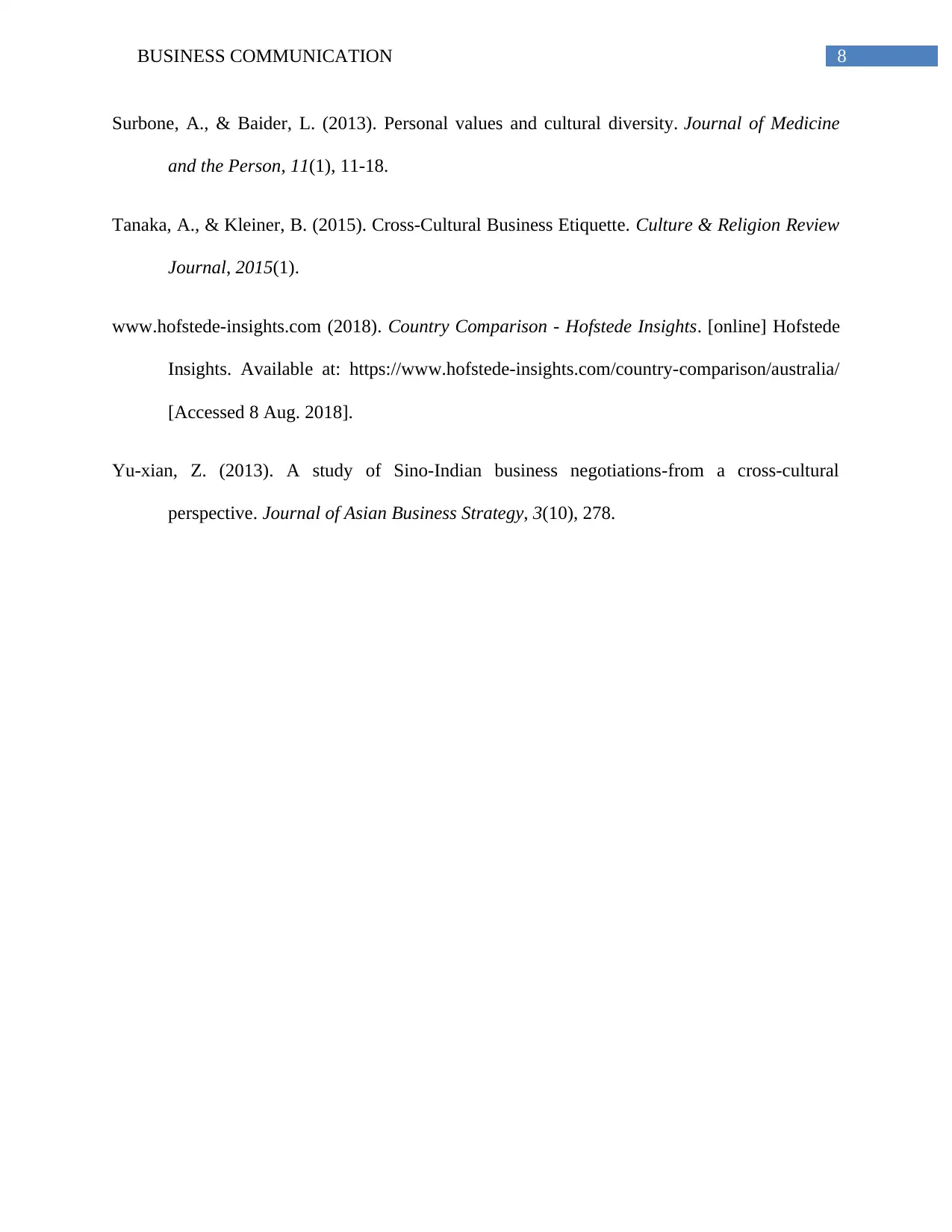
8BUSINESS COMMUNICATION
Surbone, A., & Baider, L. (2013). Personal values and cultural diversity. Journal of Medicine
and the Person, 11(1), 11-18.
Tanaka, A., & Kleiner, B. (2015). Cross-Cultural Business Etiquette. Culture & Religion Review
Journal, 2015(1).
www.hofstede-insights.com (2018). Country Comparison - Hofstede Insights. [online] Hofstede
Insights. Available at: https://www.hofstede-insights.com/country-comparison/australia/
[Accessed 8 Aug. 2018].
Yu-xian, Z. (2013). A study of Sino-Indian business negotiations-from a cross-cultural
perspective. Journal of Asian Business Strategy, 3(10), 278.
Surbone, A., & Baider, L. (2013). Personal values and cultural diversity. Journal of Medicine
and the Person, 11(1), 11-18.
Tanaka, A., & Kleiner, B. (2015). Cross-Cultural Business Etiquette. Culture & Religion Review
Journal, 2015(1).
www.hofstede-insights.com (2018). Country Comparison - Hofstede Insights. [online] Hofstede
Insights. Available at: https://www.hofstede-insights.com/country-comparison/australia/
[Accessed 8 Aug. 2018].
Yu-xian, Z. (2013). A study of Sino-Indian business negotiations-from a cross-cultural
perspective. Journal of Asian Business Strategy, 3(10), 278.
⊘ This is a preview!⊘
Do you want full access?
Subscribe today to unlock all pages.

Trusted by 1+ million students worldwide
1 out of 9
Related Documents
Your All-in-One AI-Powered Toolkit for Academic Success.
+13062052269
info@desklib.com
Available 24*7 on WhatsApp / Email
![[object Object]](/_next/static/media/star-bottom.7253800d.svg)
Unlock your academic potential
Copyright © 2020–2025 A2Z Services. All Rights Reserved. Developed and managed by ZUCOL.





